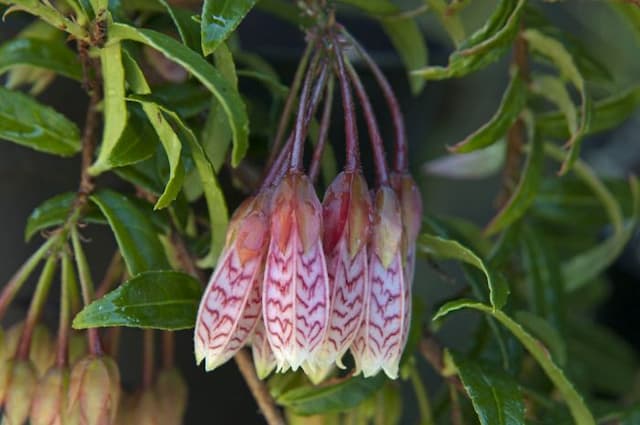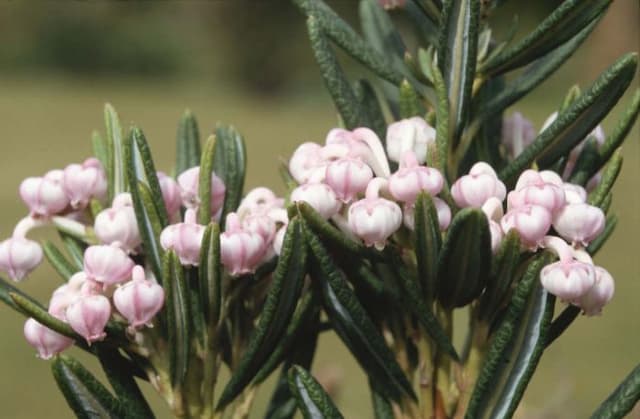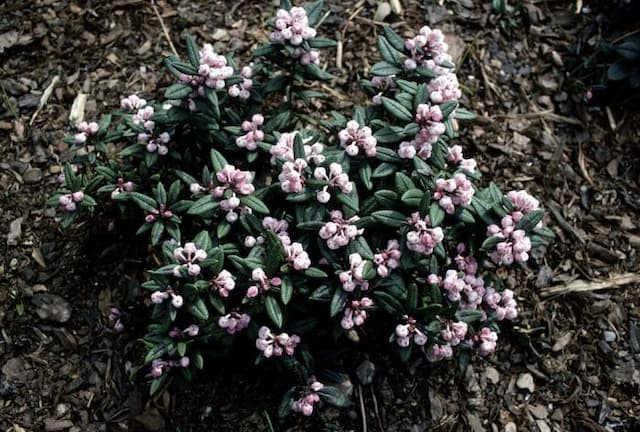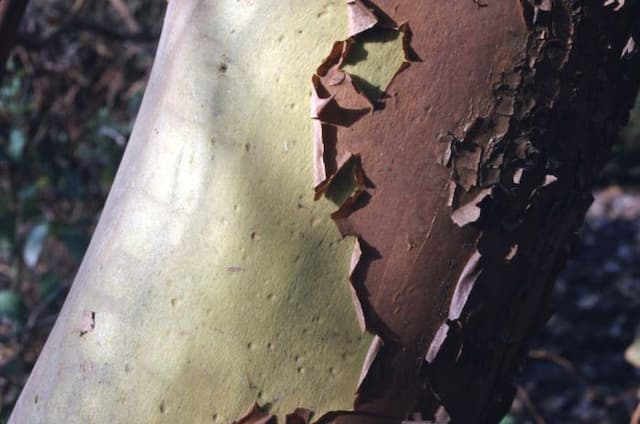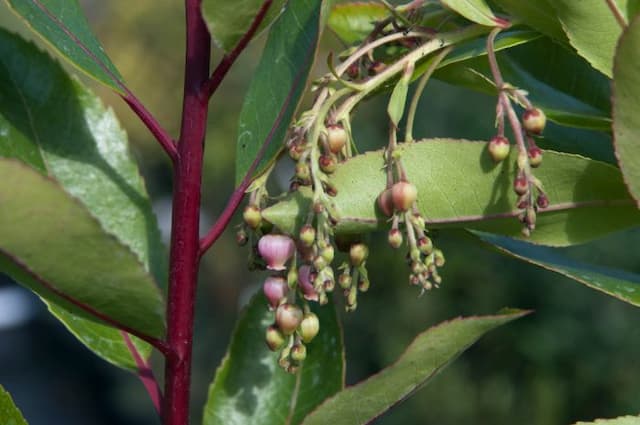Rhododendron Rhododendron 'Martha Isaacson' (Ad)

ABOUT
Rhododendron 'Martha Isaacson' is a visually striking shrub with an elegant floral display. The plant boasts large, lush evergreen leaves that create a dense, green backdrop for its flowers. These leaves often have a leathery texture, contributing to the plant's robust appearance. The most eye-catching aspect of the Rhododendron 'Martha Isaacson' is its colorful blooms. The flowers typically emerge in clusters, known as trusses, which can contain several individual blossoms. Each flower exhibits a trumpet-like shape, which is characteristic of the Rhododendron genus. The petals can display various hues, commonly vibrant shades of pink, red, purple, or white, occasionally with speckles or streaks that enhance their ornamental value. In the center of each flower, there are prominent stamens that add to the intricacy of the bloom. These may be of a contrasting color to the petals, standing out against their background. The overall impression of the Rhododendron 'Martha Isaacson' when in full bloom is one of lushness and abundance, as the masses of flowers envelop the plant, making it a spectacular sight in any garden that hosts it.
About this plant
 Names
NamesFamily
Ericaceae
Synonyms
Rhododendron, Azalea
Common names
Rhododendron 'Martha Isaacson' (Ad)
 Toxicity
ToxicityTo humans
Rhododendrons, including the variety 'Martha Isaacson,' contain toxins known as grayanotoxins. If any part of the plant, including leaves, stems, or nectar, is ingested by humans, it can lead to poisoning. The symptoms of rhododendron poisoning in humans can include vomiting, diarrhea, hypersalivation, weakness, loss of appetite, abdominal pain, and potentially, in severe cases, cardiovascular collapse or coma. Immediate medical attention should be sought if ingestion occurs.
To pets
Rhododendrons are also toxic to pets, including cats and dogs. The toxin, grayanotoxin, affects pets in much the same way as humans. Symptoms of poisoning in pets after ingesting parts of the rhododendron can include vomiting, diarrhea, drooling, weakness, lethargy, depression, a decrease in blood pressure, coma, and potentially death if not treated swiftly. Pet owners should contact a veterinarian immediately if their pet consumes any part of a rhododendron plant.
 Characteristics
CharacteristicsLife cycle
Perennials
Foliage type
Evergreen
Color of leaves
Green
Flower color
Varies
Height
6 feet 1.83 meters
Spread
6 feet 1.83 meters
Plant type
Shrub
Hardiness zones
5
Native area
Asia
Benefits
 General Benefits
General Benefits- Ornamental Appeal: Vibrant flowers and lush foliage create visual interest in gardens and landscapes.
- Habitat Support: Provides nectar and shelter for pollinators like bees and butterflies, enhancing biodiversity.
- Privacy Screen: Dense growth can be used to create a natural barrier or screen for privacy in residential areas.
- Soil Erosion Control: Sturdy root systems help stabilize soil and prevent erosion on slopes or banks.
- Seasonal Interest: Offers a variety of seasonal changes, from blooming flowers to autumnal foliage.
- Cultural Significance: Rhododendrons have been celebrated in horticulture and gardening for centuries, bringing a sense of tradition to landscapes.
- Enhances Property Value: A well-maintained landscape featuring the colorful Rhododendron can improve the curb appeal and potentially the property value of homes.
- Shade Tolerance: Can thrive in partially shaded areas where other sun-loving plants might not perform as well.
- Cold Hardy: Resilient in colder climates, making it suitable for a range of temperate regions.
- Versatility: Can be planted in a variety of settings such as woodland gardens, borders, and as specimen plants.
- Low Maintenance: Once established, requires minimal care compared to other high-maintenance garden plants.
 Medical Properties
Medical PropertiesThis plant is not used for medical purposes.
 Air-purifying Qualities
Air-purifying QualitiesThis plant is not specifically known for air purifying qualities.
 Other Uses
Other Uses- Photography Subjects: Rhododendrons, with their striking blooms, are sought after by photographers for their vibrant colors, which can add beauty to garden portfolios and nature photo collections.
- Artistic Inspiration: Artists may use rhododendrons as a reference for paintings, drawings, and illustrations due to their unique shape and array of colors.
- Natural Dye: The flowers and leaves of some rhododendrons can be used to create natural dyes for fabric, though 'Martha Isaacson' suitability for this purpose would need to be tested.
- Culinary Garnish: While many rhododendrons are toxic, some species have edible flowers. It’s imperative to verify edibility, but if non-toxic, they can serve as unique garnishes.
- Landscape Design: Rhododendrons are used in thematic gardens, such as Asian-inspired landscapes, due to their origins and prominent use in traditional Eastern gardens.
- Education: These plants can be used as educational tools in botany and horticulture classes to discuss plant care, propagation, and the importance of soil pH for plant health.
- Holiday Decor: Rhododendron foliage and flowers can be incorporated into festive wreaths and floral arrangements during the holiday season.
- Bonsai: Rhododendrons can be cultivated as bonsai plants with proper training and pruning to bring a miniature landscape indoors.
- Cultural Events: In regions where rhododendrons are native, festivals may celebrate their blooming season, and 'Martha Isaacson' could be showcased for its beauty.
- Memorial Gardens: Rhododendrons, due to their perennial nature, are often planted in memorial or remembrance gardens as living tributes to loved ones.
Interesting Facts
 Feng Shui
Feng ShuiRhododendron is not used in Feng Shui practice.
 Zodiac Sign Compitability
Zodiac Sign CompitabilityRhododendron is not used in astrology practice.
 Plant Symbolism
Plant Symbolism- Beware: The Rhododendron plant is often associated with caution due to its toxic properties, warning against what might seem inviting or beautiful.
- Warning: The plant is used to signify a threat or danger, which stems from its poisonous nature and the potential harm it can cause if mishandled or ingested.
- Temperance: Rhododendrons can symbolize moderation or restraint, as one must be careful in its presence, similar to how one should approach life with balance.
- Abundance: With its lush, vibrant blooms, the Rhododendron signifies richness and profusion, reflecting an abundance of beauty in nature.
- Elegance and wealth: The striking appearance of Rhododendrons, such as the 'Martha Isaacson' variety, can represent sophistication and prosperity, making them popular in ornamental gardens of the affluent.
 Water
WaterRhododendrons require even moisture and should be watered deeply. 'Martha Isaacson' should be watered about once a week providing about one inch of water, especially during dry spells. However, during the growing season, if the weather is exceptionally hot or windy, you may need to water more frequently. It is crucial to avoid waterlogging, so ensure that the plant has well-drained soil. You can apply roughly 1 gallon of water per square foot of soil under the rhododendron's canopy to meet the one-inch water requirement.
 Light
LightRhododendrons, including 'Martha Isaacson', thrive in dappled shade or partial sunlight. They should not be exposed to full, direct hot sun, especially in the afternoon, as it can lead to leaf scorch. The ideal spot is one where the plant receives filtered sunlight, such as beneath a tall canopy of deciduous trees, receiving morning sun and afternoon shade or vice versa.
 Temperature
TemperatureRhododendrons like 'Martha Isaacson' prefer moderate temperatures and can generally tolerate minimum temperatures down to about 5°F, although some protection may be necessary in colder climates. Ideally, they thrive in a temperature range between 40°F and 75°F. Extreme heat above 80°F can be damaging, so providing shade during the hottest part of the day in summer can help keep the plant healthy.
 Pruning
PruningPrune 'Martha Isaacson' Rhododendrons to maintain shape, remove deadwood, and encourage bushier growth. The best time for pruning is soon after the flowers fade in spring. You shouldn't need to prune more than once a year, and removing spent flower clusters (deadheading) can promote better growth and flowering for the next season.
 Cleaning
CleaningAs needed
 Soil
SoilRhododendrons, including 'Martha Isaacson', thrive best in well-draining, acidic soil with a pH between 4.5 and 6.0. A suitable soil mix can be made of equal parts peat moss, pine bark, and perlite. Regularly testing and adjusting soil pH is crucial for the health of the plant.
 Repotting
RepottingRhododendrons like 'Martha Isaacson' generally require repotting every 2 to 3 years to prevent root crowding. Choose a pot only slightly larger than the previous one to avoid excess soil moisture, which can lead to root rot.
 Humidity & Misting
Humidity & MistingRhododendrons such as 'Martha Isaacson' favor moderate to high humidity levels, ideally between 40-60%. They perform well in a naturally humid outdoor environment or indoors where humidity can be maintained through humidifiers or pebble trays.
 Suitable locations
Suitable locationsIndoor
Place in cool spot with indirect light and monitor humidity.
Outdoor
Partial shade, protect from wind, and mulch the root zone.
Hardiness zone
5-8 USDA
 Life cycle
Life cycleThe Rhododendron 'Martha Isaacson' begins its life cycle as a seed, which under appropriate conditions of moisture and temperature, will germinate and develop into a seedling. As it grows, it enters a vegetative stage consisting of a period of robust leaf and stem growth, during which root development also strengthens the plant's foundation. As the plant matures, it enters the flowering stage, where it produces distinctive blooms typical of the Rhododendron genus—often colorful and attracting pollinators. After pollination, if successful, the flowers give way to seed pods, which will eventually disperse seeds for the next generation. Throughout its life, the plant undergoes periods of dormancy, typically in colder months, where growth slows or pauses, helping it to conserve energy. Rhododendron 'Martha Isaacson' may live for many years, going through these growth cycles repeatedly, with proper care and favorable conditions.
 Propogation
PropogationPropogation time
Spring-Early Summer
Propogation: The most popular method of propagating the Rhododendron 'Martha Isaacson' is through semi-hardwood cuttings. This technique involves selecting healthy, semi-mature stems from the current year’s growth in the late summer or early fall months. Cuttings should be about 4 to 6 inches (10 to 15 centimeters) long and include several leaf nodes. Leaves on the lower half of the cutting are removed, and the cut end is often dipped in a rooting hormone to increase the chances of successful rooting. The prepared cuttings are then placed in a mixture of peat and perlite or a similar well-draining medium, and kept under high humidity and indirect light until roots develop, which usually takes several weeks. Maintaining a consistent temperature around 70°F (21°C) can also aid in the rooting process. It's important to avoid direct sunlight and keep the soil moist but not waterlogged to encourage healthy root growth without rot setting in.
